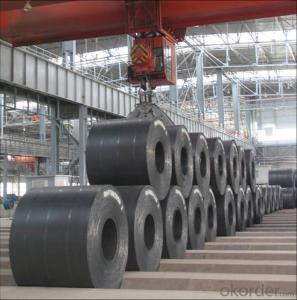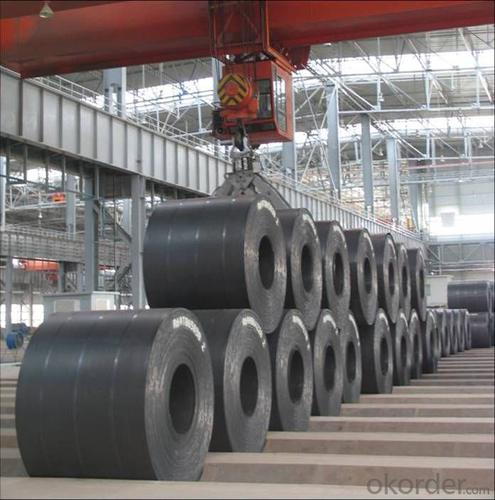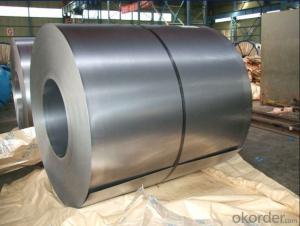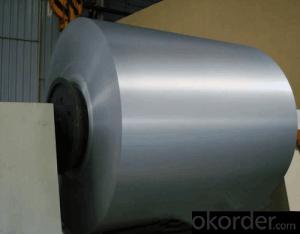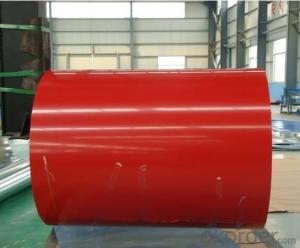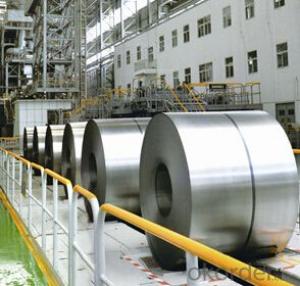AISI, ASTM, BS, DIN, GB, JIS Cold Rolled Steel Coil
- Loading Port:
- Tianjin
- Payment Terms:
- TT OR LC
- Min Order Qty:
- 20 m.t.
- Supply Capability:
- 15000 m.t./month
OKorder Service Pledge
OKorder Financial Service
You Might Also Like
Quick Details
Standard: AISI, ASTM, BS, DIN, GB, JIS
Steel Grade: ASTM653A; DX51D+Z JISG 3302 CGCC
Thickness: from 0.15mm to 3.0mm
Place of Origin: Tianjin, China (Mainland)
Technique: Cold Rolled
Surface Treatment: cold rolled
Application: Construction
Model Number: Steel Coil
Width: from 914mm to 1250mm
Length: Coil or cliens requirements
Delivery time: about 30-60 working days
Packaging Detail: Fully seaworthy export packing with paper tube
Coil weight: 3-10 ton or client's suggestion
Packaging & Delivery
Packaging Details:
Fully seaworthy export packing with paper tube
Delivery Detail:
about 30-40 working days if the quantity below 500 ton
- Q: How are steel coils inspected for thickness?
- Steel coils are inspected for thickness using a non-destructive testing method called ultrasonic testing. In this process, high-frequency sound waves are transmitted through the coil, and the time it takes for the waves to bounce back is measured. This allows for precise measurement of the thickness of the steel coil, ensuring it meets the required specifications.
- Q: If rail ties were melted, would they be like any other type of steel?
- Steel okorder ... If care is not taken in the method used to melt the steel that alloy will change because the carbon will burn in the process. Also part of a steels rating is a result of heat treatments used. When melted it will loose those properties. By the way rail road ties are either wood or concrete- not steel.
- Q: What are steel coils used for?
- Steel coils are used for a variety of applications, including manufacturing automobiles, construction materials, appliances, and machinery. They are also used in the production of pipes, electrical appliances, and packaging materials.
- Q: for instance Cr-Ni steeldoes this refer to plated steel or a uniform mixture
- stainless steel is an alloy normally iron with additions of C, Mn, Ni, Cr, and Nb - amounts added depend on properties required. Corrosion resistance is due to a very thin but dense layer of chromium oxide which forms at the surface and prevents further attack. Ordinary steel on the other hand becomes coated with a porous layer of iron oxide(rust) through which the atmosphere can pass and cause further corrosion.
- Q: How are steel coils inspected for defects after recoiling?
- Steel coils are inspected for defects after recoiling by conducting visual inspections, using non-destructive testing methods such as ultrasonic testing or magnetic particle inspection, and conducting measurements to check for dimensional accuracy and straightness.
- Q: What are the different methods of coil joining for steel coils?
- There exists a variety of techniques for joining steel coils, each with its own advantages and limitations. Some commonly employed methods encompass the following: 1. Welding: Among the most popular methods of coil joining, welding involves the use of heat to melt and fuse the edges of steel coils. Arc welding, resistance welding, or laser welding can be utilized for this purpose. Welding offers a robust and durable joint, although it can be time-consuming and necessitate skilled operators. 2. Mechanical fastening: This technique entails the use of mechanical fasteners like clips, staples, or bolts to connect the edges of steel coils. Mechanical fastening is relatively quick and straightforward, and it allows for easy disassembly if needed. However, the joint may not be as strong as welding and can be prone to loosening over time. 3. Adhesive bonding: Adhesive bonding involves the use of a suitable adhesive or glue to bond the edges of steel coils. This approach yields a strong and uniform joint, while also providing protection against corrosion. However, adhesive bonding may require surface preparation and curing time, and it might not be suitable for high-temperature applications. 4. Interlocking or tongue-and-groove joints: This method involves shaping the edges of steel coils in a manner that they interlock or fit together like puzzle pieces. Interlocking joints provide good alignment and are easily assembled and disassembled. Nevertheless, they may not yield as strong a joint as welding or mechanical fastening. 5. Coil-overlapping: In this method, the edges of steel coils are overlapped and clamped together using mechanical means. Coil-overlapping is a simple and cost-effective technique, albeit it may not yield a strong joint and can result in uneven coil edges. When selecting the appropriate method of coil joining for steel coils, it is crucial to consider factors such as application requirements, strength requirements, cost, and production efficiency.
- Q: I work at a tool store. I told my boss last week we needed more pruning shears so he did get more of all kinds. Thing is out of all of the shears he brought Two of different kinds say they are made out of Japanese steel. I have never heard of Japanese steel so now i ask you (the public) whats the difference between it and steel from the US or any other country? Those shears are worth more then the ones he gets from Mexico and China and even more than Black and Decker, Fiskars, etc but not more then Corona brand ones.
- After WWII, The United States in order to help the Japanese get back on their feet, sent over the equipment needed to make the newest types of foundries available at the time. While this was a big boon for the Japanese, this meant that most of our foundries were using the older technologies. Japanese Steel then had a bit of a edge on purity than ours did and when you have a purer steel, you have a better product. Since then, they've stayed at the top of the game when it comes to steel. Not only because of the equipment which we have caught up with them on and stay with them on, but because they also have a stronger tradition regarding steel. They have made quality steel blades that were decades ahead of what the West could produce. So you couple that quality of metallurgy with modern techniques we gave them, they took steel making and and ran with it to be one of the top steel producers in the world. Don't get me wrong. We in the US can make Steel as well as they can. But we have ranges of steel. You can get a steel tool that is as good as a Japanese offering (if not more so) but at the same time you can also get a steel tool that is well...Dollar Store crap that'll break if you look at it wrong. While their best may not be better than our best, their worst is often far better quality than our worst. Their lower end products are often our medium grade tools and blades.
- Q: Ok, so im gonna get my tragus pierced and i was wondering which is better, titanium or stainless steel. I hear like everyone uses stainless steel , but is titanium better?Thanks
- It seems like less people are allergic to titanium than surgical grade steel.
- Q: How are steel coils used in the production of metal facades?
- Steel coils are used in the production of metal facades as the primary material. These coils are unwound and then processed through various manufacturing techniques, such as cutting, shaping, and forming, to create the desired facade panels. The steel coils provide strength, durability, and versatility, allowing for the creation of aesthetically pleasing and functional metal facades in various architectural applications.
- Q: I know copper pots are supposed to be really good for cooking with, and I have been looking around online. One thing I don't want to do, however, is send them in to be re-lined with tin. So I was wondering if stainless steel lined copper pots work as well as the traditional tin lined ones, or if those make the copper just for looks.
- Stainless steel is durable and does not disolve and make things taste funny. Stainless steel is not a good conductor of heat, so it has hot and cold spots. Copper is very good conductor. They noe bond copper to stainless steel to get the best features of each. Some pots just have a very thin copper plating to fool you. A good pot will be heavier, It is really hard to tell from looking.if it is plating or a bonded layer of copper. the thicker the better
Send your message to us
AISI, ASTM, BS, DIN, GB, JIS Cold Rolled Steel Coil
- Loading Port:
- Tianjin
- Payment Terms:
- TT OR LC
- Min Order Qty:
- 20 m.t.
- Supply Capability:
- 15000 m.t./month
OKorder Service Pledge
OKorder Financial Service
Similar products
Hot products
Hot Searches
Related keywords
